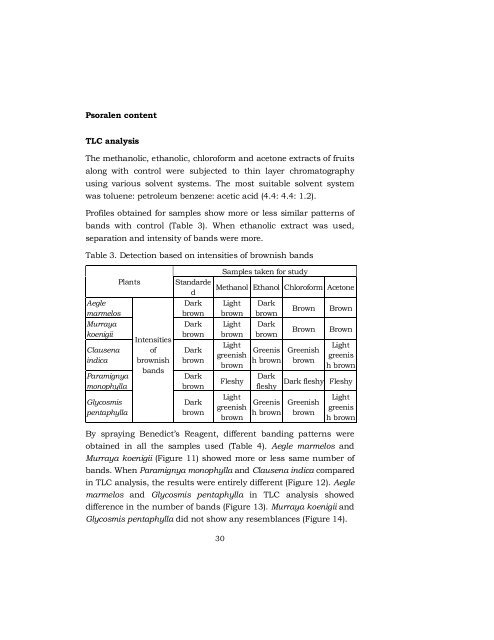Qualitative and quantitative analysis of biologically active principles ...
Qualitative and quantitative analysis of biologically active principles ...
Qualitative and quantitative analysis of biologically active principles ...
You also want an ePaper? Increase the reach of your titles
YUMPU automatically turns print PDFs into web optimized ePapers that Google loves.
Psoralen content<br />
TLC <strong>analysis</strong><br />
The methanolic, ethanolic, chlor<strong>of</strong>orm <strong>and</strong> acetone extracts <strong>of</strong> fruits<br />
along with control were subjected to thin layer chromatography<br />
using various solvent systems. The most suitable solvent system<br />
was toluene: petroleum benzene: acetic acid (4.4: 4.4: 1.2).<br />
Pr<strong>of</strong>iles obtained for samples show more or less similar patterns <strong>of</strong><br />
b<strong>and</strong>s with control (Table 3). When ethanolic extract was used,<br />
separation <strong>and</strong> intensity <strong>of</strong> b<strong>and</strong>s were more.<br />
Table 3. Detection based on intensities <strong>of</strong> brownish b<strong>and</strong>s<br />
Aegle<br />
marmelos<br />
Murraya<br />
koenigii<br />
Clausena<br />
indica<br />
Paramignya<br />
monophylla<br />
Glycosmis<br />
pentaphylla<br />
Plants<br />
Intensities<br />
<strong>of</strong><br />
brownish<br />
b<strong>and</strong>s<br />
St<strong>and</strong>arde<br />
d<br />
Dark<br />
brown<br />
Dark<br />
brown<br />
Dark<br />
brown<br />
Dark<br />
brown<br />
Dark<br />
brown<br />
Samples taken for study<br />
Methanol Ethanol Chlor<strong>of</strong>orm Acetone<br />
Light<br />
brown<br />
Light<br />
brown<br />
Light<br />
greenish<br />
brown<br />
Fleshy<br />
Light<br />
greenish<br />
brown<br />
Dark<br />
brown<br />
Dark<br />
brown<br />
Greenis<br />
h brown<br />
Dark<br />
fleshy<br />
Greenis<br />
h brown<br />
Brown<br />
Brown<br />
Greenish<br />
brown<br />
Brown<br />
Brown<br />
Light<br />
greenis<br />
h brown<br />
Dark fleshy Fleshy<br />
Greenish<br />
brown<br />
Light<br />
greenis<br />
h brown<br />
By spraying Benedict’s Reagent, different b<strong>and</strong>ing patterns were<br />
obtained in all the samples used (Table 4). Aegle marmelos <strong>and</strong><br />
Murraya koenigii (Figure 11) showed more or less same number <strong>of</strong><br />
b<strong>and</strong>s. When Paramignya monophylla <strong>and</strong> Clausena indica compared<br />
in TLC <strong>analysis</strong>, the results were entirely different (Figure 12). Aegle<br />
marmelos <strong>and</strong> Glycosmis pentaphylla in TLC <strong>analysis</strong> showed<br />
difference in the number <strong>of</strong> b<strong>and</strong>s (Figure 13). Murraya koenigii <strong>and</strong><br />
Glycosmis pentaphylla did not show any resemblances (Figure 14).<br />
30

















